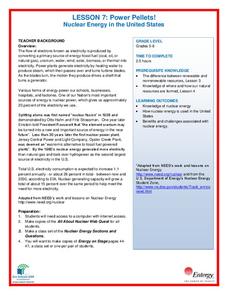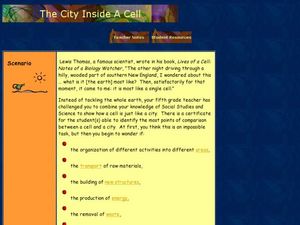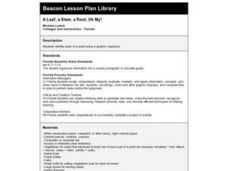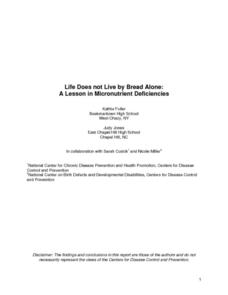Curated OER
How Does A Seed Become A Plant?
First graders evaluate what it takes for a seed to become a plant. They brainstorm what they know, discuss what they want to know and interact with a Plant WebQuest that indicates what they have learned. They also examine how we get the...
Curated OER
WebQuest: The Growing Challenge in Senegal
Students examine the issue of soil infertility in Senegal. For this agriculture lesson, students follow the steps to complete the provided webquest that requires them to learn about the issue and create a 3-year plan for planting in the...
National Wildlife Federation
Power Pellets! Nuclear Energy in the United States
Nuclear power provides about 20 percent of the energy generated in the United States. The seventh activity in the series of 12 tackles nuclear power. After sharing what they know about nuclear energy, scholars complete a WebQuest make a...
Curated OER
Native American Three Sisters Gardens
Students investigate companion planting. In this communtiy gardening lesson students explore the tradition of the Native American Three Sisters gardening approach. Students act as botanists, anthropologists, folklorists, and curators.
AAAS
Wildflower Garden
Take your blooming botanists on a spring walk without activating any allergies with a wildflower WebQuest. The link to the "Spring Wildflower Walk" is broken, but the correct link is attached here. You could also try the activity in the...
Curated OER
The City Inside a Cell
Students compare cell structure to the structure of a city. For this cell structure lesson, students investigate differences and similarities between cell structure and city structure. Students create a 3-dimensional, edible model of a...
Curated OER
A Leaf, a Stem, a Root, Oh My!
Students conduct Internet research on plants and complete a WebQuest on vegetable plants. They use a graphic organizer to display their findings, observe actual vegetables and design a salad, noting which part of each plant is included.
Curated OER
Beans Are Seeds
Second graders read literature regarding the growth of seeds. They investigate how seeds need water and light to sprout and then grow. They experiment by planting their own bean seeds. They record the progress of their seeds in both...
Curated OER
Plants and Animals of Great Bay Animals and Plants of the Estuary
Students participate in a webquest about the plants and animals that inhabit an estuary. They role play as environmentalists researching this habitat and present the results of their research in a creative way.
Curated OER
Lewis and Clark
Ninth graders study the plants and animals Lewis and Clark discovered on their expedition. There is a plant illustrator, a plant recorder, an animal illustrator, and an animal recorder. They research the plants and animals and the ...
Curated OER
Sowing Seeds of the Future
Learners explore how to preserve native wild plants and garden crops. In this science lesson, students play the role of botanists and research North American plants. Learners create a presentation about their findings.
Curated OER
Investigating Factors That Affect Cell Membrane Permeability
Cell membranes and the factors that affect its integrity are studied, with Beet tissue used as the model. A poster to display findings of the permeability of the membranes would clarify understanding and also allow a layer of language...
Curated OER
Life Does Not Live By Bread Alone
Learners investigate the relationship between micronutrients and proper metabolic function. The lesson should serve as an introduction to the subject. The subject of the function includes the study of plants, animals, and humans. They...















